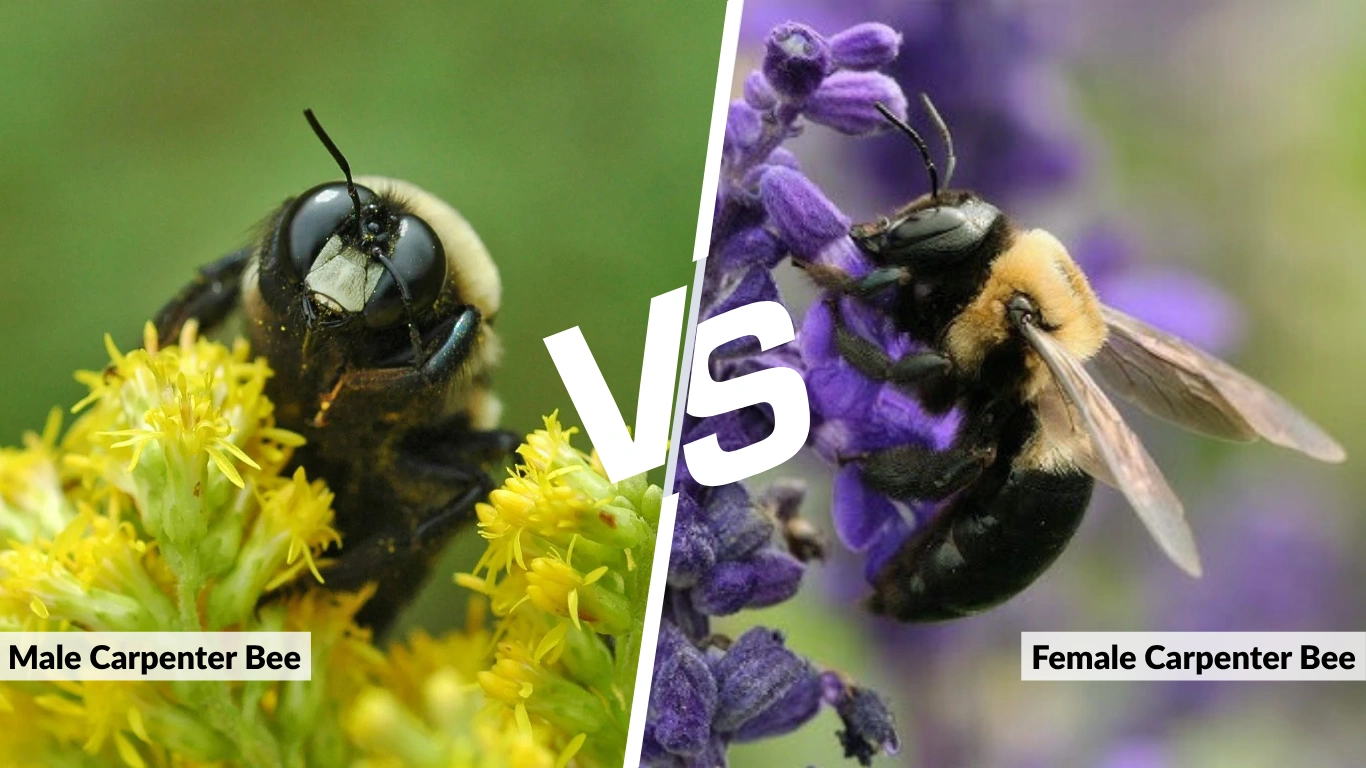Carpenter bees are large, shiny pollinators often mistaken for bumblebees due to their size and buzzing sound. Despite their similar appearance, male and female carpenter bees have distinct characteristics that make them easy to identify once you know what to look for. Understanding their differences is important not only for recognition but also for knowing which one can sting and how they behave around humans.
Physical Appearance of Carpenter Bees
Carpenter bees (genus Xylocopa) exhibit clear physical distinctions between males and females. The most obvious difference lies in the color of their faces. Males have white or yellow patches on their faces, while females have entirely black faces. This contrast makes facial color one of the easiest identifiers in the field.
Their abdomen texture also helps in identification. Both sexes have shiny, almost hairless abdomens, but females often appear darker and glossier, while males look slightly lighter with golden hairs near the thorax. Females tend to be slightly larger and sturdier, adapted for drilling wood to build nests, whereas males are leaner and more agile fliers.
Identifying Male Carpenter Bees
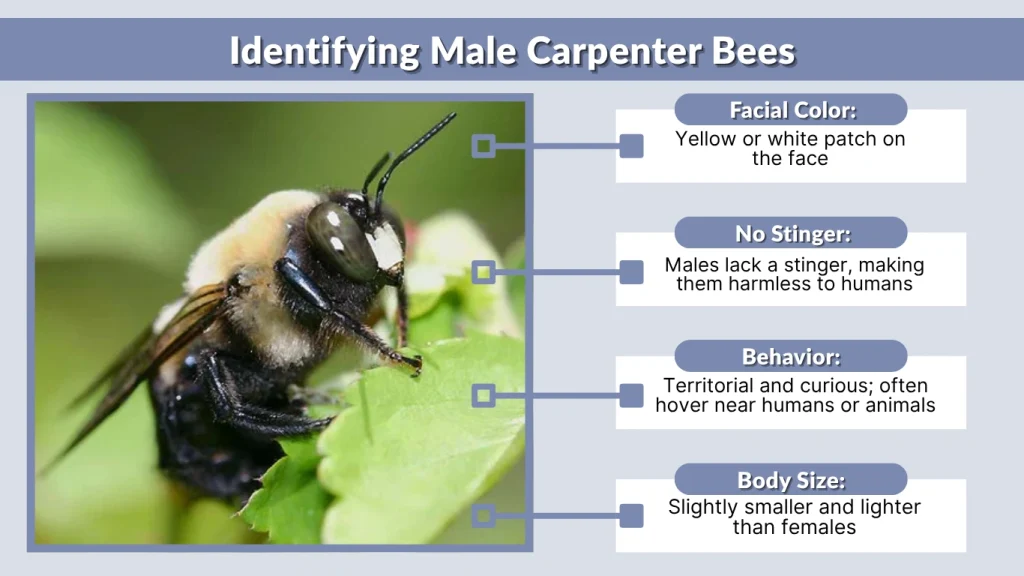
Key Features
- Facial Color: Yellow or white patch on the face
- No Stinger: Males lack a stinger, making them harmless to humans
- Behavior: Territorial and curious; often hover near humans or animals
- Body Size: Slightly smaller and lighter than females
Male carpenter bees are the ones you’ll usually notice hovering in front of wooden surfaces, fences, or eaves. They appear aggressive—sometimes darting toward intruders—but it’s all an act. Since males have no stinger, they pose no real threat. Their role centers around guarding the nest and attracting females during mating season.
You’ll also spot males more frequently on warm, sunny days, especially in spring when new generations emerge. Their buzzing and protective flight patterns make them easy to observe without danger.
Identifying Female Carpenter Bees
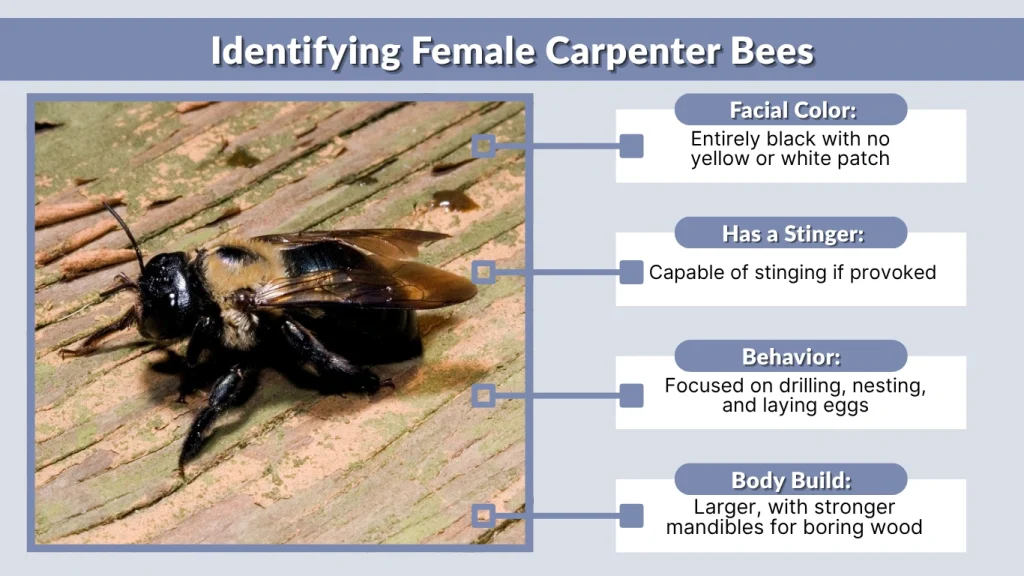
Key Features
- Facial Color: Entirely black with no yellow or white patch
- Has a Stinger: Capable of stinging if provoked
- Behavior: Focused on drilling, nesting, and laying eggs
- Body Build: Larger, with stronger mandibles for boring wood
Female carpenter bees are the engineers of the species. They use their powerful jaws to drill perfectly round holes in wood, forming tunnels to lay eggs. These holes are typically about half an inch wide and can go several inches deep. Females spend much of their time collecting pollen and nectar to store inside the tunnels for their offspring.
Although females have stingers, they’re not aggressive and will rarely sting unless physically threatened. Their natural focus on nesting makes them less noticeable compared to the more visible and flighty males.
Behavior: Male vs Female Carpenter Bees
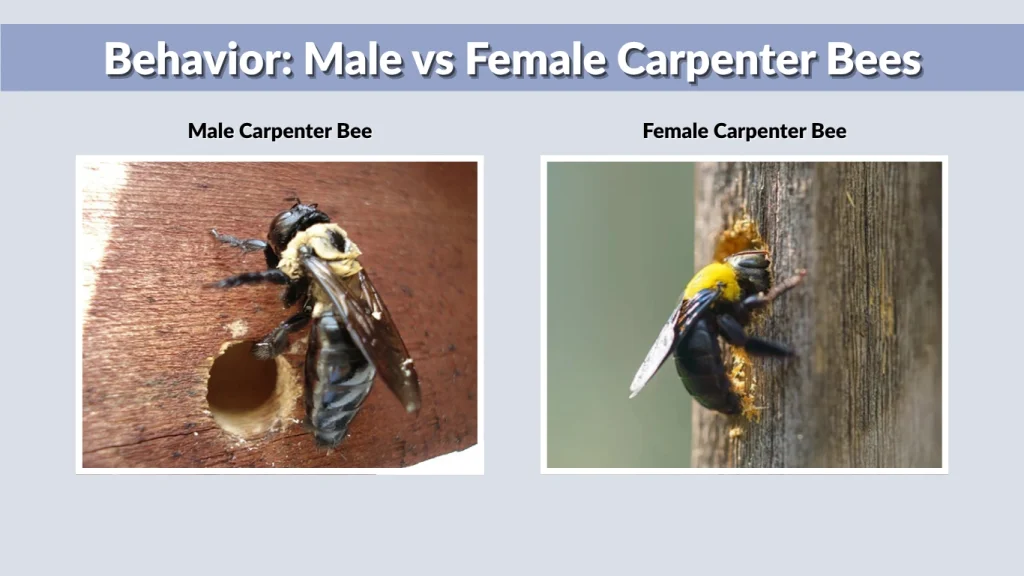
Behavioral differences are as striking as physical ones. Male carpenter bees act like aerial guards. They hover around nest entrances, chase away other insects, and even approach humans out of curiosity. However, their “attack” is harmless since they cannot sting.
Female carpenter bees, on the other hand, are practical and task-oriented. They handle all the nesting duties—drilling holes, provisioning them with food, and sealing them for their larvae. Males rarely enter the tunnels and are more involved in protecting the area from a distance.
This division of roles keeps the colony efficient and ensures the next generation is safely nurtured within wooden structures, tree trunks, or even fence posts.
Stinging and Aggression
Among carpenter bees, only females can sting because males lack stingers entirely. However, even stings from females are rare. They are generally docile unless their nest or body is directly threatened.
When carpenter bees hover around humans, it’s usually the males exhibiting territorial behavior, not aggression. Females, while capable of defending themselves, prefer to flee or hide inside their tunnels. Therefore, encounters with carpenter bees are mostly harmless, and they play an important role in pollination.
If stung by a female carpenter bee, the reaction is typically mild—similar to a honeybee sting—but unlike honeybees, females do not die after stinging and can sting multiple times if provoked.
Nesting and Hole-Drilling Habits
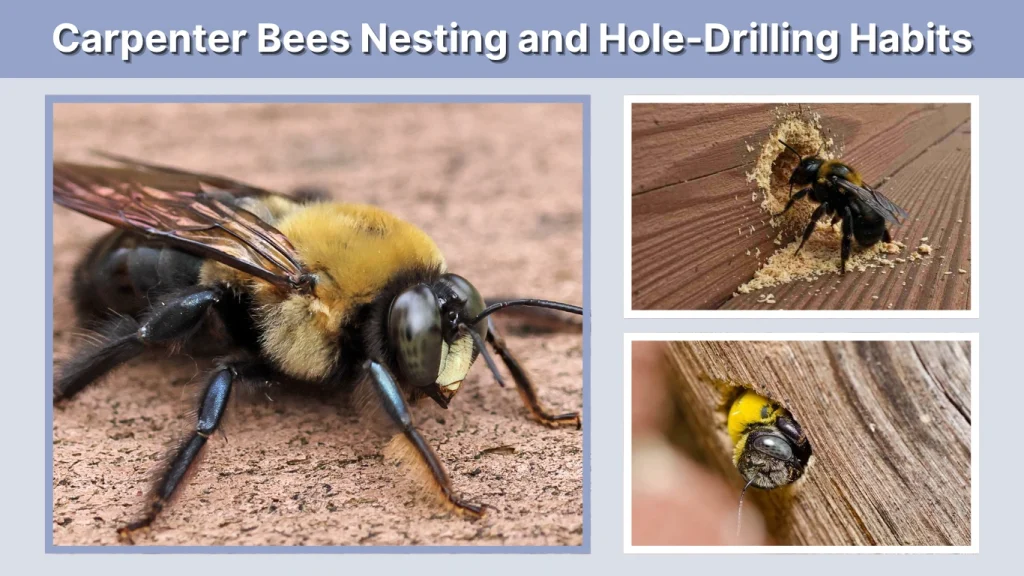
The female carpenter bee is solely responsible for drilling nesting tunnels. She carves through untreated or soft wood, such as pine, cedar, or cypress, creating chambers to lay her eggs. Once a tunnel is complete, she divides it into sections using wood pulp walls, each containing an egg and a supply of pollen for the larva.
Males never drill holes; instead, they patrol the nesting area to deter other insects. This activity can make them seem aggressive, but it’s just protective instinct. Females generally reuse existing tunnels from previous years, which can lead to more extensive internal damage to wood over time.
Do Female Carpenter Bees Leave the Nest?
Female carpenter bees usually stay near their nests throughout the breeding season. After laying eggs and sealing the tunnels, they may remain inside for protection or to maintain the structure. Once the larvae mature and emerge, females sometimes reuse or expand the same tunnels the following year. Their strong attachment to nesting sites often leads to recurring activity in the same wooden areas.
Eastern and Valley Carpenter Bee Comparison
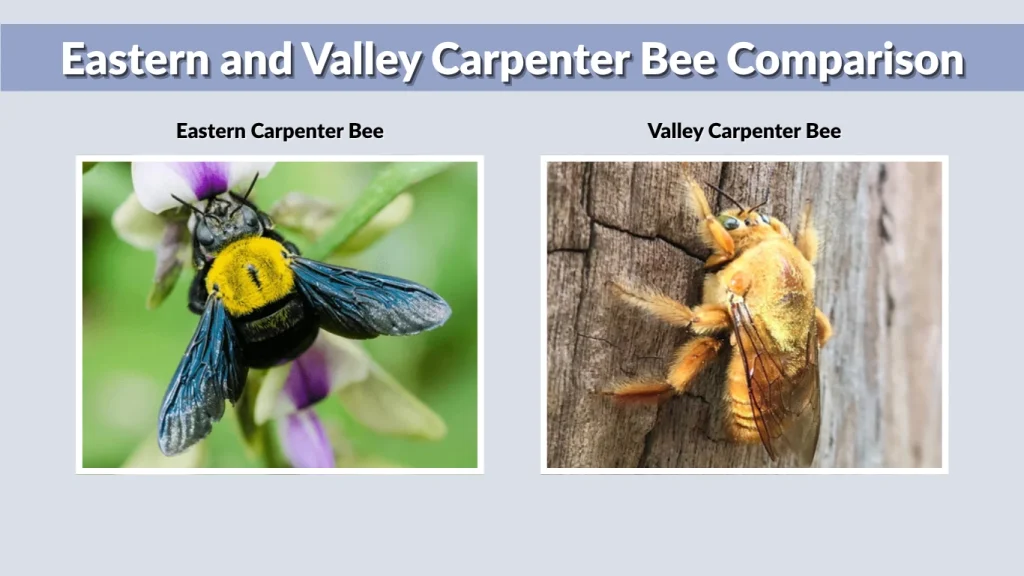
Carpenter bee appearance and behavior vary by species, particularly between Eastern and Valley carpenter bees. Recognizing these differences helps with proper identification and control.
Eastern Carpenter Bee
- Male: Has a pale yellow or white patch on the face and a slightly fuzzy thorax.
- Female: Glossy black body with no facial patch.
- Behavior: Found in the eastern U.S., often nesting in decks, fences, and roof eaves.
Valley Carpenter Bee
- Male: Distinct golden or tan body, giving it a “teddy bear” appearance.
- Female: Completely black and shiny.
- Behavior: Common in California and warmer western regions, often nesting in soft, sun-exposed wood.
These species share similar nesting habits but differ in coloration and regional distribution, making identification easier once you know the visual cues.
How to Tell Male and Female Carpenter Bees Apart
Distinguishing male and female carpenter bees becomes simple with a few quick checks. Look for the facial color first—white or yellow marks mean male, while an all-black face means female. You can also observe their behavior: males hover near people or patrol open areas, whereas females stay close to wooden surfaces, drilling or entering tunnels.
Quick Identification Checklist
- Face Color: Yellow/white = Male | Black = Female
- Body Size: Male = Smaller | Female = Larger
- Behavior: Male = Territorial | Female = Nesting
- Stinger: Male = None | Female = Yes
Once you’ve seen them in action, these differences become easy to spot even from a distance.
Why These Differences Matter
Understanding the difference between male and female carpenter bees is essential for managing them safely. Homeowners often mistake hovering males for stinging threats, leading to unnecessary fear. In reality, males cannot sting and serve primarily as guards. Females, while capable of stinging, are peaceful and essential for pollination and reproduction. Recognizing which is which allows people to handle carpenter bee infestations with care instead of panic.
FAQs
What’s the difference between a male and female carpenter bee?
Male carpenter bees have pale faces and lack stingers, while females have black faces and can sting. Females drill into wood to build nests, whereas males stay nearby to guard and attract mates through hovering behavior.
Do female carpenter bees sting?
Yes, only females possess a stinger, but they rarely use it. They are non-aggressive and usually sting only when grabbed or directly threatened. Most stings occur accidentally when someone handles or disturbs their nesting sites.
Are most carpenter bees female?
Both sexes exist in nearly equal numbers, but females are more often noticed near wooden structures because of their nesting behavior. Males tend to patrol open areas, making them more visible during mating season.
Do male or female carpenter bees drill holes?
Only female carpenter bees drill holes in wood. They use their strong mandibles to create tunnels for laying eggs and storing pollen. Males never drill and mainly protect the entrance to the nest.
How can you tell male and female carpenter bees apart quickly?
The easiest way to tell them apart is by their face color and behavior. Males have yellow or white facial patches and no stinger, while females have solid black faces and are usually found boring holes into wooden surfaces.

